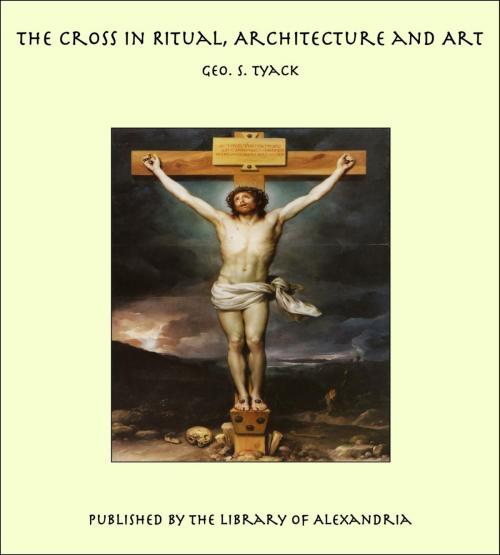The Cross in Ritual, Architecture and Art
Nonfiction, Religion & Spirituality, New Age, History, Fiction & Literature| Author: | Geo. S. Tyack | ISBN: | 9781465542892 |
| Publisher: | Library of Alexandria | Publication: | March 8, 2015 |
| Imprint: | Language: | English |
| Author: | Geo. S. Tyack |
| ISBN: | 9781465542892 |
| Publisher: | Library of Alexandria |
| Publication: | March 8, 2015 |
| Imprint: | |
| Language: | English |
It is strange, yet unquestionably a fact, that in ages long before the birth of Christ, and since then in lands untouched by the teaching of the Church, the Cross has been used as a sacred symbol. The Aryan tribes, ancestors of most of the European nations, so regarded a cross of curious form, whose four equal arms were all turned midway at a right angle. The excavations of Dr. Schliemann on the site of ancient Troy have brought to light discs of baked clay stamped with a cross. It is well known that the crux ansata, or Tau Cross (T), sometimes with the addition of a ring, as if for suspension, at the top, is found in Egyptian inscriptions. The Greek Bacchus, the Tyrian Tammuz, the Chaldean Bel, and the Norse Odin, were all symbolized to their votaries by a cruciform device. The Spanish conquerors of Mexico found the cross already an object of reverence among the Aztecs, carved on temple walls, on amulets, and on pottery; so, too, in North America, specimens of shell-work, engraved with crosses of various forms, have been unearthed from mounds raised by the native Indian tribes. It is further interesting to note that the sign was frequently regarded as an emblem of deity, or as a symbol of favourable import. To the Egyptians it spoke of a future life; to the Aryans of fire, itself emblematic of life; the Mongolians lay it, drawn on paper, on the breasts of their dead; and the Buddhists of Thibet see in it a mark of the foot-print of Buddha. In all this the Christians of the first age would have rejoiced, claiming it as a world-wide prophecy of the Cross of the Redeemer, just as they drew a similar lesson from the frequency with which the cross forms, more or less roughly, the shape of the ordinary implements of man’s handicraft. “Consider all things in the world,” writes Justin Martyr, in his apology addressed to the Emperor Antoninus Pius, “whether without this form they could be administered or could have any community. For the sea is not crossed except that trophy which is called a sail remain safe aboard the ship; nor is the earth ploughed without it; diggers and mechanics do not their work except with tools of this shape. And the human form differs from that of brute beasts in nothing but in being erect, and having the arms extended. The power of this figure is even shown by your own symbols, on what are named ‘vexilla’ and trophies, with which all your processions are made, using these, even though unwittingly, as signs of your authority and dominion.” Although we should be unwilling to-day to accept as argument all that a pious, yet simple, fancy, or the warmth of a fervid rhetoric, suggested to men of former times; it would, nevertheless, be equally, or more absurd for us to follow others, who have endeavoured to trace the mere survival of heathen custom in the Christian use of the Cross. That such is not the case is clear, in spite of a few parallels in teaching as curious as those above referred to, from the fact that the Cross amongst us symbolizes the Faith, not as an arbitrary or mystic sign, but as the natural expression of an historical fact
It is strange, yet unquestionably a fact, that in ages long before the birth of Christ, and since then in lands untouched by the teaching of the Church, the Cross has been used as a sacred symbol. The Aryan tribes, ancestors of most of the European nations, so regarded a cross of curious form, whose four equal arms were all turned midway at a right angle. The excavations of Dr. Schliemann on the site of ancient Troy have brought to light discs of baked clay stamped with a cross. It is well known that the crux ansata, or Tau Cross (T), sometimes with the addition of a ring, as if for suspension, at the top, is found in Egyptian inscriptions. The Greek Bacchus, the Tyrian Tammuz, the Chaldean Bel, and the Norse Odin, were all symbolized to their votaries by a cruciform device. The Spanish conquerors of Mexico found the cross already an object of reverence among the Aztecs, carved on temple walls, on amulets, and on pottery; so, too, in North America, specimens of shell-work, engraved with crosses of various forms, have been unearthed from mounds raised by the native Indian tribes. It is further interesting to note that the sign was frequently regarded as an emblem of deity, or as a symbol of favourable import. To the Egyptians it spoke of a future life; to the Aryans of fire, itself emblematic of life; the Mongolians lay it, drawn on paper, on the breasts of their dead; and the Buddhists of Thibet see in it a mark of the foot-print of Buddha. In all this the Christians of the first age would have rejoiced, claiming it as a world-wide prophecy of the Cross of the Redeemer, just as they drew a similar lesson from the frequency with which the cross forms, more or less roughly, the shape of the ordinary implements of man’s handicraft. “Consider all things in the world,” writes Justin Martyr, in his apology addressed to the Emperor Antoninus Pius, “whether without this form they could be administered or could have any community. For the sea is not crossed except that trophy which is called a sail remain safe aboard the ship; nor is the earth ploughed without it; diggers and mechanics do not their work except with tools of this shape. And the human form differs from that of brute beasts in nothing but in being erect, and having the arms extended. The power of this figure is even shown by your own symbols, on what are named ‘vexilla’ and trophies, with which all your processions are made, using these, even though unwittingly, as signs of your authority and dominion.” Although we should be unwilling to-day to accept as argument all that a pious, yet simple, fancy, or the warmth of a fervid rhetoric, suggested to men of former times; it would, nevertheless, be equally, or more absurd for us to follow others, who have endeavoured to trace the mere survival of heathen custom in the Christian use of the Cross. That such is not the case is clear, in spite of a few parallels in teaching as curious as those above referred to, from the fact that the Cross amongst us symbolizes the Faith, not as an arbitrary or mystic sign, but as the natural expression of an historical fact















